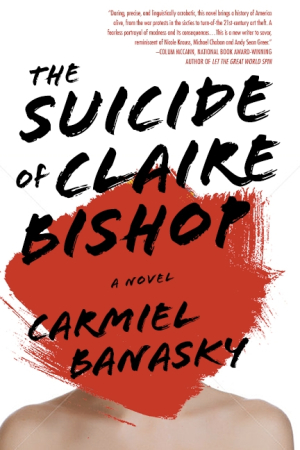The Suicide of Claire Bishop
Memory, mental illness, and modern art are central themes in this clever literary puzzle.
“There are so many ways to die, and even more ways to imagine it.” Carmiel Banasky’s first novel, The Suicide of Claire Bishop, questions magical thinking: if you can imagine something, by painting a suicide on canvas, for instance, can you prevent it from happening in real life? Add in the artist’s apparent time travel and her boyfriend’s bizarre conspiracy theories, and the result is a twisty, satisfying story about truth and madness.
For Claire Bishop’s thirty-fifth birthday in 1959, her husband commissions a portrait by Nicolette Bernhardt. To their surprise, it depicts Claire jumping off of Brooklyn Bridge, an unpleasant reminder of familial mental illness. Claire demands the portrait’s destruction, but it survives, changing hands illegally several times over the years until West Butler, a schizophrenic data miner, sees it in a gallery in 2004. He recognizes the work as his girlfriend Nicolette’s—but she was not even born in 1959. West determines to steal the portrait one last time and return it to its rightful owner.
Narration alternates between a third-person record of Claire’s life—divorce, hosting an anti-Vietnam War collective, and caring for a mother with Alzheimer’s—and West’s first-person account of searching for the truth behind the painting. When he abandons his medication, his language perfectly reflects his unhinged state: he addresses his “loyal voices” in the second person and excises the words “crazy” and “sorry” from all writing. His hypothesis about Nicolette’s work is a startling blend of Hawkingesque time bending, sadistic Hasids, and disappearing bees. Banasky successfully translates West’s confusion into a fresh, surprising voice: “I have all these wet lumps of clay in my brain that used to be my speech.”
Magic realism is an intriguing undercurrent here, but it never overwhelms the plot. Drawing strong generational parallels, Banasky shows how mental illness might threaten memory and art. What endures time’s losses? And is it ever possible to escape one’s fate? Fans of Siri Hustvedt’s The Blazing World and Judith Claire Mitchell’s A Reunion of Ghosts have a treat in store.
Reviewed by
Rebecca Foster
Disclosure: This article is not an endorsement, but a review. The publisher of this book provided free copies of the book to have their book reviewed by a professional reviewer. No fee was paid by the publisher for this review. Foreword Reviews only recommends books that we love. Foreword Magazine, Inc. is disclosing this in accordance with the Federal Trade Commission’s 16 CFR, Part 255.

